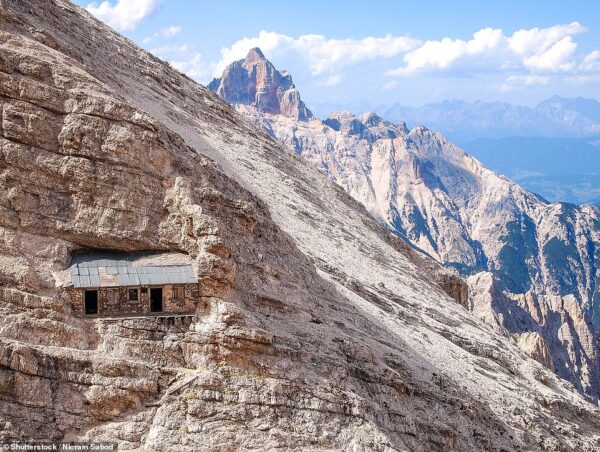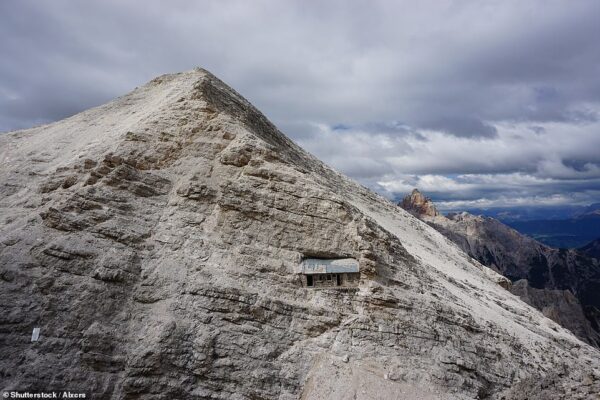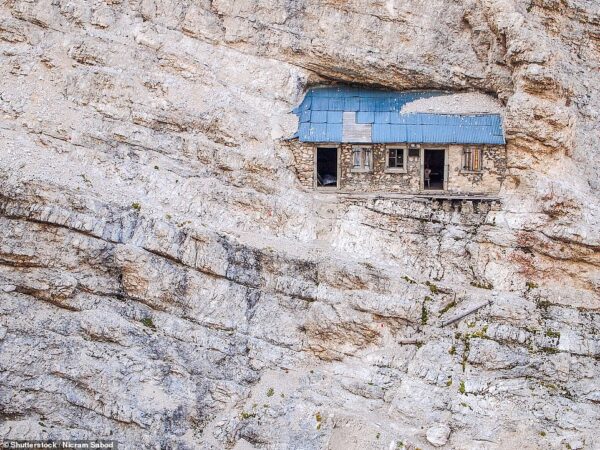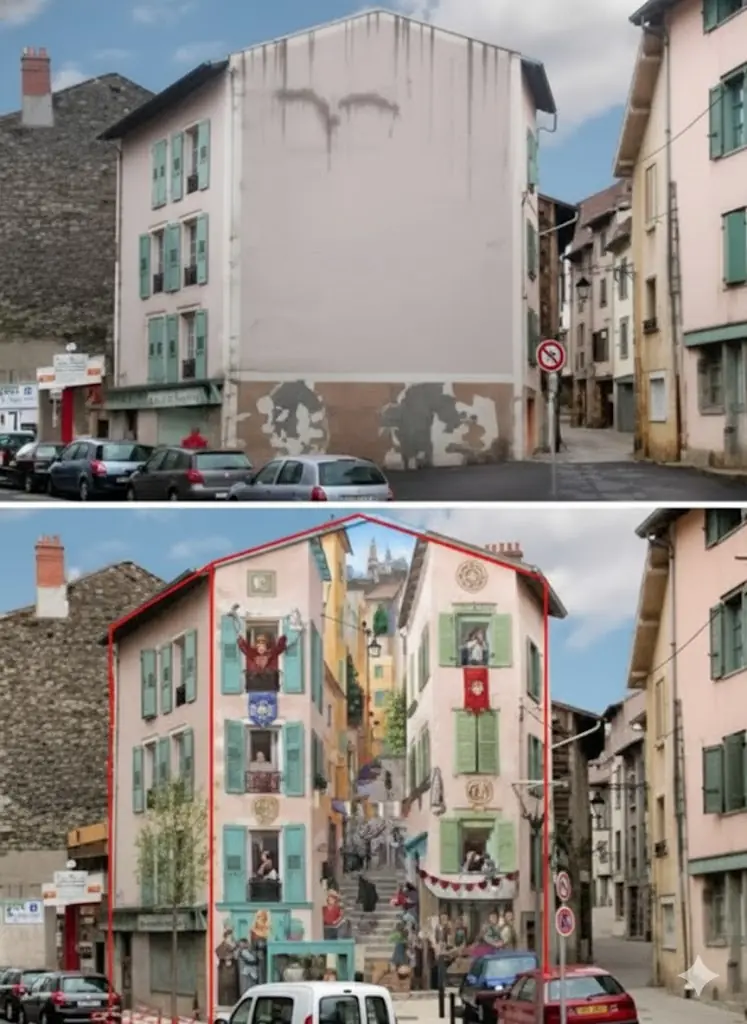
Pictured: Incredible Alpine refuge from World War I embedded in the sheer rockface of a mountain in Italy’s Dolomites



Tucked high into the jagged peaks of the Monte Cristallo massif, within the breathtaking Natural Park of the Ampezzo Dolomites, lies an extraordinary piece of wartime history—a refuge built directly into the face of a vertical cliff. This improbable shelter, perched over 2,700 meters (8,858 feet) above sea level, was likely constructed by Italian troops during the brutal mountain warfare of World War I.
It is believed that soldiers carved out and built this outpost as part of their struggle against Austro-Hungarian forces during what became known as the White War, named for the freezing, snow-laden battle conditions that defined this front in the Dolomites. The shelter, which now stands abandoned, remains a haunting testament to human resilience, ingenuity, and survival in one of the most unforgiving environments imaginable.
Not for the Faint of Heart
Today, this remarkable refuge is only accessible to the most daring hikers and climbers traveling along the Via Ferrata Ivano Dibona, a legendary alpine route built for the bold. Known as an "iron path", the Via Ferrata consists of fixed steel cables, rungs, and ladders embedded into the mountain, designed to help climbers safely navigate the steep and exposed terrain.
As you ascend the ridge below the refuge, you’ll need a head for heights and nerves of steel. The trail is both physically demanding and mentally exhilarating. When hikers reach the cliffside cabin, many pause for photos—either sitting in the doorway or standing just inside the weathered wooden frame, marveling at the valley stretching far below.
From a distance, the refuge appears as if it were impossibly glued to the sheer rock wall. With brick walls, a slanted roof, and wooden-framed doors and shuttered windows, it blends almost seamlessly into the mountain itself. Step out of the doorway, and it feels as though you might fall directly into the vast void beneath.
A Forgotten Outpost in the Sky
Constructed during a time of extreme hardship, this refuge was likely accessed by soldiers using rope ladders and primitive cableways. They hauled weapons, ammunition, and supplies through snowstorms and across glacier fields, building tunnels and precarious routes through the Dolomites’ icy heart.
Avalanches were not just natural disasters—they were weapons. Both the Italian and Austro-Hungarian armies deliberately triggered them to wipe out enemy positions. Amid this chaos, shelters like the one in Monte Cristallo offered rare moments of protection and rest.
Climbers today still pass remnants of this war-torn past. The mountain preserves scars of the conflict: rusted barbed wire, collapsed outposts, and weathered signs of former military activity.
The Ivano Dibona Route and Its Legendary Landmarks
The Via Ferrata Ivano Dibona starts near Cortina d’Ampezzo, a renowned ski resort town nestled along the Boite River. The trail is a favorite among experienced mountaineers and history buffs alike. According to local tourism boards, it “requires a high level of fitness” and is best suited for seasoned climbers.
Along the route, adventurers cross the Ponte Cristallo, a suspension bridge measuring 27 meters (89 feet) in length. The bridge gained Hollywood fame in 1993 when Sylvester Stallone dashed across it in the action-packed film Cliffhanger.
On the other side of the bridge sits the Guido Lorenzi mountain hut, an equally photogenic spot perched atop a high mountain pass. It’s one of several landmarks along this historic route, many of which bear the marks of past battles.
War Echoes in the Ice
The Dolomites were officially declared a UNESCO World Heritage Site in 2009, not only for their dramatic beauty but also for their geological and historical significance. Hidden among their peaks are dozens of similar wartime shelters and fortifications, slowly decaying with time but never forgotten.
As climate change accelerates glacier melt across the Alps—including the nearby Ortles-Cevedale and Adamello-Presanella ranges—artifacts from the White War are reemerging from the ice. In recent years, rusted rifles, personal belongings, handwritten postcards, and even unopened cans of food have been discovered, perfectly preserved by decades of cold.
One of the most astonishing finds occurred on Mount Scorluzzo, where an entire WWI military encampment was uncovered after a glacier thawed. Soldiers’ clothing, cooking utensils, and documents offered a chilling window into the daily lives of those who once endured these frozen battlefields.
A Mountain Monument to Memory
The Monte Cristallo refuge is more than just a destination for thrill-seekers—it’s a symbol of endurance and a stark reminder of the sacrifices made in extreme conditions. Every brick, shutter, and ledge whispers the stories of those who built it, fought nearby, and braved the brutal elements in the name of duty.
For those who choose to venture there, it’s not just a physical journey—it’s a step back in time, across a path carved in rock and history.
News in the same category


Reason Why You Should Always Shower At Night

For those who use hair ties, you should know this

The Atlantic Current That Shapes Our World Faces Collapse

World’s Largest Bromeliad, ‘Queen of the Andes’, Blooms Only Once in a Century

20 Incredible Before & After Street Art Transformations That Are Simply Stunning Friday 10, 2020Art22,027 Views

After the mother swan dies, the father swan takes the youngsters under his wing

Massive Bird Nests Built on Telephone Poles in Southern Africa are Home to Multiple Species of Birds

1 Hen, 76 Ducklings: What’s The Deal With This Photo?

Image of Full Moon Through a Rock Formation Looks Like a Giant Eye

NASA astronaut going to the Moon next year reveals bizarre act he plans to do moments before takeoff

YouTuber tests jailbroken AI to see if it would break his legs to avoid being shut down

Astronaut Ron Garan: “From Space, Earth Shows Us We’re Living a Lie”

Astronomers Detect Mysterious “Dark Star” 3,000 Light-Years Away — A Discovery That Could Rewrite Physics

Stanford Scientists Create Solar Panels That Can Generate Power at Night

James Webb Spots a “Black Hole Star” – A Cosmic Phenomenon That Could Rewrite Astronomy

Internet users mourn iconic feature as AOL officially takes it offline

'Godfather of AI' issues stark warning that total human extinction is a very real possibility
News Post

Rafael Nadal’s Greatest Match: Fighting for Forgotten Dogs

The Officer, the Boy, and the Box of Pokémon Cards.

Grandma’s “Stray Cat” Turns Out to Be a Cougar.

The Walmart Employee Who Became a Hero to a Struggling Mom

Two Wounds, One Journey: The Woman and Dog Who Taught Each Other Grace

A Prom Filled With Love: Young Man’s Selfless Gesture Becomes Unforgettable

A Brother’s Sacrifice: How MJ Became a Hero in a Split Second

K-9 Apollo: A Hero’s Fight for Life and the Community That Saved Him

“One Last Climb: A Man, His Dog, and a Wheelbarrow Full of Love”

The Stranger Who Stopped: How One Man’s Kindness Saved a Puppy’s Life

Why You Should Avoid Leaving a Glass of Water Near Your Bed

Reason Why You Should Always Shower At Night

Place a plate of salted lemon at the head of the bed: Get 5 great benefits and secrets that unfortunately few people know

Add this to the water. Even when you don’t clean the floor in a week

💖 My Nana Knew What She Was Doing — Time-Honored Skincare Wisdom (And What Really Works Today)

Know this trick to distinguish real honey from fake honey, don't be afraid of being tricked into buying poor quality products

Add a few slices of fresh lemon to the pot of boiled eggs: Get great benefits, many people do not know

Extraordinary Visual Skills If You Can Spot The Cat

What does this gesture signify?
